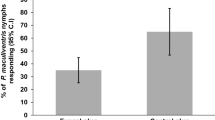Abstract
Four-armed airflow olfactometer was used to determining the foraging behavior ofPteroptrix longgiclava (Girault) (Hymenoptera: Aphelinidae) andEncarsia gigas (Tshumakova) (Hymenoptera: Aphelinidae) to the essential oils which emitted from the healthy bark ofPopulus pseudo-simonii×P. nigra, the infested bark injured byQuadraspidiotus gigas (Thiem & Gerneck), the body and scale of fixed 1st-instar-nymph ofQ. gigas. The results from these experiments showed that the volatile oils produced from the injured bark and from the scale of fixed 1st-instar-nymph had a higher attractive ability to female adults of the two species of wasps. The essential oil produced from the scale of the pest at dosages of 3–7 μL and the essential oil emitted by injured bark at dosages of 5–9 μL had a stronger alluring effect on the host searching behavior ofPteroptrix longgiclava. The essential oil from the body of fixed 1st-instar-nymph ofQ. gigas also had certain effect on the host locating effort ofPteroptrix longgiclava andEncarsia gigas. Those two wasps did not shown any reaction to the essential oil produced by the healthy bark of poplar.
Similar content being viewed by others
References
Bai Shuxiong, Wang Zhenying, He Kanglai. 2001. The host and habitat location behavior of Hymenopterous parasitoids Mediated by Semiochemicals [J]. Chinese Journal of Biological Control,17(2): 86–91. (in Chinese)
Ding Hongjian, Guo Yuyuan, Wu Hongcai. 1996. Designning, producing and application of four-armed olfactometer for the research on the olfactory behavior of insect. Entomological Knowledge,33(4): 241–243. (in Chinese)
Guo Xuefei, Yin Huiwei, Yan Shanchun,et al. 1997. Sampling and analyzing of volatile odorant of plant [J]. Journal of Northeast Forestry University,25(5): 105–108.
Han Baoyu, Chen Zongmao. 1999. Selective ofAphidius sp. to various odor sources. Journal of Tea Science,19(1): 29–34. (in Chinese)
Jacqueline B.F., Greevliet, W.L., Dicke, M.,et al. 1994. Volatiles from damaged plants as major cues in long range host searching by the specialist parasitoidCotesia rubecula [J]. Ento. Exp. Appl.,73: 282–297
Lewis, W.J., Nordlund, R.C., Gueldner, P.E.A.,et al. 1982. Kairomones and their use for management of entomophagous insects [J]. J. Chem. Ecol.,8: 1323–1331.
Liu Yong, Hu Cui, 2001. Effect of volatiles from different trophic level on foraging behavior ofAphidius avenae [J]. Chinese Journal of Applied Ecology,12(4): 581–584. (in Chinese)
Noldus, L.P.J.J. 1988. Response of the egg parasitoidTrichogramma petiosum to the sex pheromone of its hostHeliothis zea [J]. Ento. Exp. Appl.,48: 293–300.
Price, P.W., Bouton, C.E., Gross, P.,et al. 1980. Interaction among three trophic levels: influence of plants on interactions between insect herbivores and natural enemies [J]. Ann. Rev. Ecol. Syst.,11: 41–65.
Tao Shuxia, Wan Fanghao, Tong Zhanhua,et al. 2000. Allelochemicals for egg parasitoids,Trichogramma chilonis andT. dendrolimi resources and activity bioassay [J]. Scientia Agriculture Sinica,33(6): 59–66. (in Chinese)
Vet, L.E.M., Dicke, M. 1992. Ecology of infochemical use by natural enemies in a tritrophic context [J]. Ann. Rev. Ent.,37: 141–172.
Vet, L.E.M., Diche, M., Wachers, F.L. 1991. How to hunt for hiding hosts: the reliability detect-ability problem in foraging parasitoids [J]. Neth. J. Zoo.,37: 141–172.
Xiao Chun, Du Jiawei. 2000. Determination of the response of cotton bollworm (Helicoverpa armigera) to plant Volatiles by selective olfactometer [J]. Acta Agriculture Jiangxi,12(2): 24–28. (in Chinese)
Xu Jianxiang, Wu Jincai, Cheng Xianian,et al. 2001. Host-searching behavior ofDiadegma insulare (Cresson) [J]. Jiangsu Agricultural Research,22(2): 33–38. (in Chinese)
Xu weian, Li Zhaohui, Ye Baohua. 2000. Chemical regulation of semiochemical on the action of host-selection by parasitoid [J]. Journal of Shandong Agricultural University (Natural Science),31(3): 320–324. (in Chinese)
Xu Zhaifu. 2000. Herbivore-induced volatile and its recruitment to the Hymenopterous parasitoids of herbivore [J]. Natural Enemies of Insects,22(3): 128–134 (in Chinese)
Yan Shanchun, Sun Jianghua, Hu Yinyue,et al. 1999. Response tests of cone flies (Strobilomyia spp.) to Dahurian Larch cone volatiles [J]. Entomologia Sinica,6(4): 329–335. (in Chinese)
Zhan Feng, Kan Wei, Zhang Zhongning. 2001. Progress in chemical ecology of tritrophic interactions among host-plants, aphids and natural enemies [J]. Acta Ecologiua Sinica.21(6): 1025–1033. (in Chinese)
Zhang Ying, Guo Bingqun, Hou Zhaoyuan,et al. 1998. Olfactory orientation of the parasitoid waspLysiphlebus fabarum to its host food plants[J]. Entomologia Sinica,5(1): 74–82.
Zhou Qiong, Liang Guangwen. 2001. The plant volatiles and their effect on host location of aphids [J]. Entomological Knowledge,38(5): 334–336. (in Chinese)
Author information
Authors and Affiliations
Corresponding author
Additional information
Foundation item: This paper was supported by National Natural Science Foundation of China (39970620) and the “TRAPOYT”
Biography: CHI De-fu (1962-), male, Ph.D., Professor in Northeast Forestry University, Harbin 150040, P.R. China
Responsible editor: Chai Ruihai
Rights and permissions
About this article
Cite this article
De-fu, C., Rubio, R.O., Shan-chun, Y. et al. Foraging behavior of parasitoid chalcid to the essential oil from bark ofPopulus pseudo-simonii×P. nigra andQuadraspidiotus gigas . Journal of Forestry Research 13, 255–259 (2002). https://doi.org/10.1007/BF02860086
Received:
Issue Date:
DOI: https://doi.org/10.1007/BF02860086
Keywords
- Populus pseudo-simonii×P. nigra
- Quadraspidiotus gigas (Thiem & Gerneck)
- Pteroptrix longgiclava (Girault)
- Encarsia gigas (Tshumakova)
- Essential Oil
- Parasitoid
- Foraging behavior




